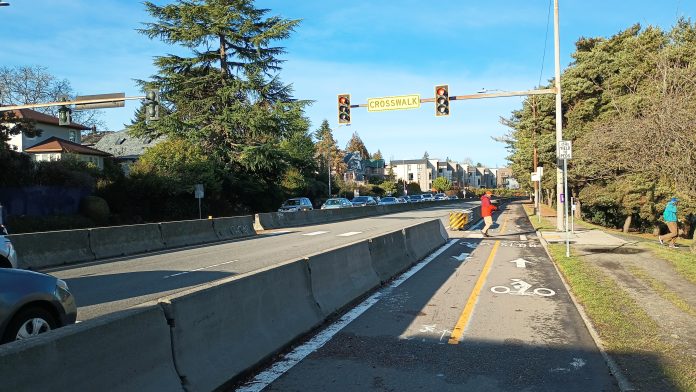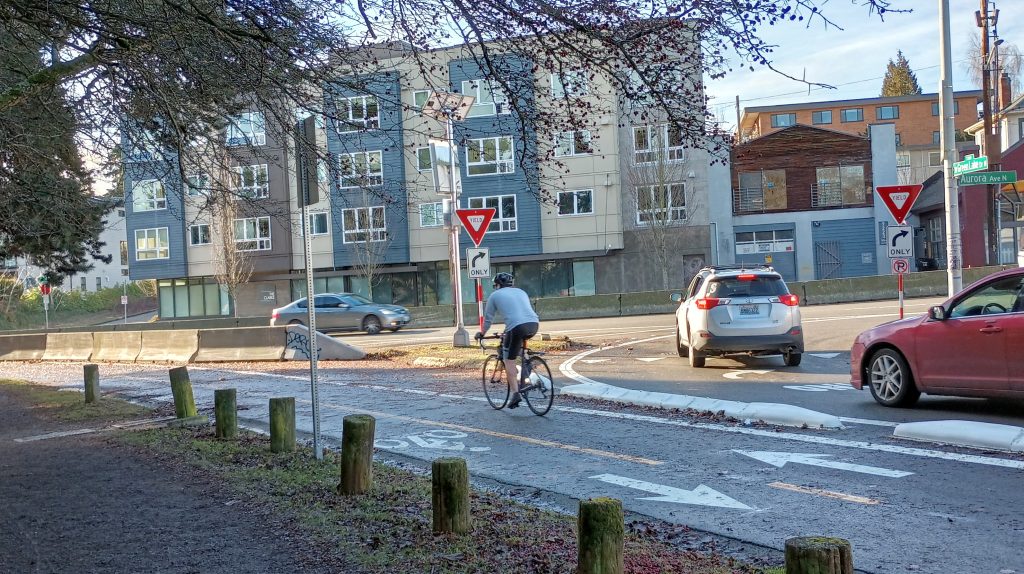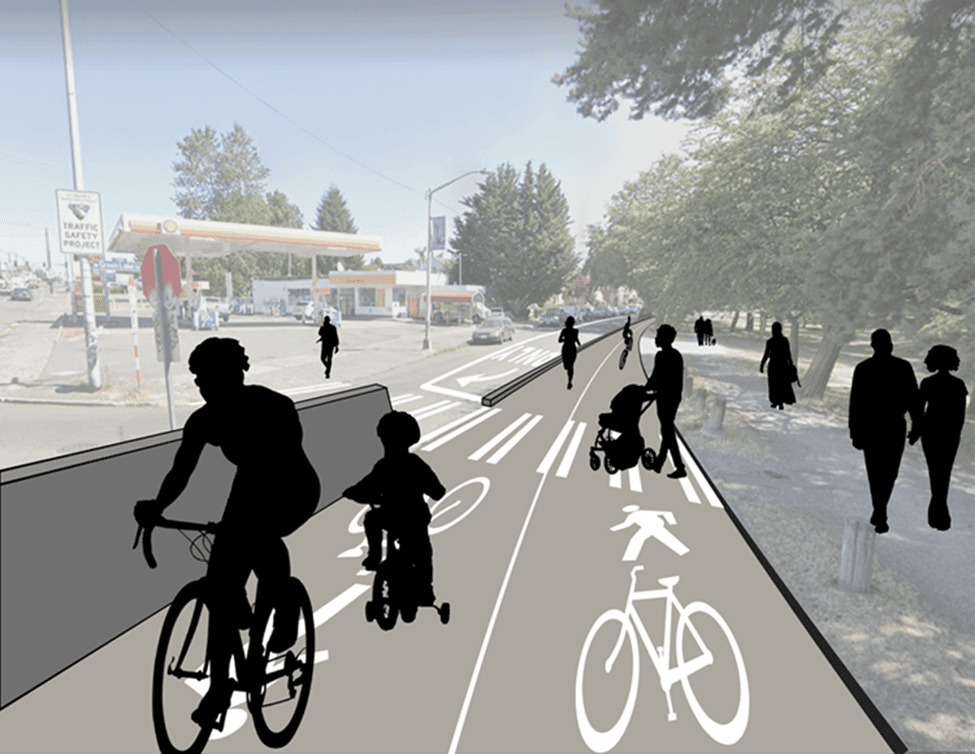
A last minute switch to a dedicated bike lane went against previous public outreach.
During a valuable Seattle winter sunbreak on a weekend afternoon, Green Lake Park buzzes with activity. The inner loop trail, popular with recreational walkers and parents with kiddos, is bustling. It’s too crowded for many runners, who opt instead to use the new Outer Loop path, which repurposes a former underutilized traffic lane of Aurora Avenue N. Before the creation of the Outer Loop, a dirt path that filled regularly with mud was the only choice for someone walking along the edge of the park along Aurora.
Completed by the Seattle Department of Transportation (SDOT) last fall, the Green Lake Outer Loop was developed out of conversations around how to expand walking, biking, and rolling space near one of the city’s biggest parks. Records from 2020 show plans were drawn up for a potential “Stay Healthy Street” on a lane of Aurora where pedestrians and people on bikes would be encouraged to mix. But by the time that the Green Lake Outer Loop opened, it was touted not as a shared use path but a dedicated bike lane.
That pivot, from a project that SDOT clearly touted as benefiting people walking, rolling, or biking, to one that is on paper only for people biking or on scooters, went unnoticed by many. It was only when Douglas MacDonald, the former Washington State Department of Transportation (WSDOT) secretary and a close observer of SDOT’s pedestrian activities in North Seattle, emailed the department with feedback on how to improve the interactions between the wide variety of types of users enjoying the new path, and was surprised to learn that most of those users weren’t technically allowed to be there.

“To be consistent with ADA standards, Green Lake Outer Loop is a Bike Facility and has been marked with our standard bike facility signs and markings. Its intended use is for wheeled users, such as bikes, scooters, rollerblades, and other modes of active transportation,” the Green Lake Outer Loop team wrote to MacDonald in late January. “We ask that pedestrians use the inner loop or outer gravel path within Green Lake Park, since the Outer Loop will primarily be used by people on wheels, who are often traveling faster than most pedestrians.”
This is likely a surprise to anyone who had been following the project, which had been promoted as a shared use path through most of its outreach.
“When complete, the Green Lake Outer Loop project will provide a better-connected loop path around the outside of Green Lake Park. This means safer, more comfortable travel options for people walking, running, biking, and rolling, as well as connections to surrounding neighborhoods in the area,” a February 2022 post on SDOT’s blog stated.
But by September, the department was calling it a “biking path.” Renderings that had shown a walking person as well as a bike stenciled on the pathway were updated to remove the person walking. MacDonald noted that an SDOT survey conducted on the project found that 74% of respondents said they got around the immediate neighborhood around Green Lake by walking or rolling, compared to only 51% biking.

So what happened? As alluded to in that email to MacDonald, the change centered around designing the project to meet the standards of the Americans with Disabilities Act (ADA).
“Early designs and maps of the project labeled the proposed facility as a shared-use path,” SDOT spokesperson Ethan Bergerson told The Urbanist. “An in-depth review of the designs by our ADA team as we approached the 90% design milestone determined that it was more accurate to describe the project as a bike lane to be consistent with ADA standards and how we refer to other similar projects throughout the city.”
Bergerson explained that in order for the project to meet ADA standards as a shared use path, accessibility features like curb ramps, signal crossing buttons, and tactile strips would had to be relocated to the other side of the pathway.
“This would have meant rebuilding the N 68th St pedestrian crossing signal so that the push button was on the other side of the path at the new edge of the street. It may have also have meant redesigning the N 77th St and Winona Ave N intersections, and any locations where the path crosses over driveways,” Bergerson said. “It would not have been feasible to make all these changes to the design and still build the project in 2022.”
Without any plans to make the substantive changes that would allow the Outer Loop to truly become a shared use path, the bike lane’s official use and its actual use will remain out of alignment. People running, walking, or rolling who are comfortable in a bike lane will likely use the path, but some will likely not. The ADA standards exist for a reason, and the design that’s in place now will by definition exclude some people. Of course, not having any path at all would have excluded even more users.
The new Green Lake Outer Loop does provide a more accessible route to Green Lake Park for many different road users. But the last minute switch to a dedicated bike facility, noticed almost exclusively by transportation advocates who follow these projects, illustrates the need for transparency within SDOT. There is a credible claim that the public process misled people, and for the department to be shirking its responsibilities under the ADA. This example emerges as a red flag and cautionary tale for future SDOT projects.
Ryan Packer has been writing for The Urbanist since 2015, and currently reports full-time as Contributing Editor. Their beats are transportation, land use, public space, traffic safety, and obscure community meetings. Packer has also reported for other regional outlets including Capitol Hill Seattle, BikePortland, Seattle Met, and PubliCola. They live in the Capitol Hill neighborhood of Seattle.


